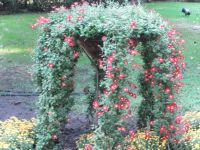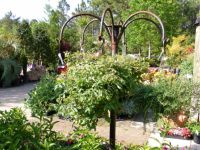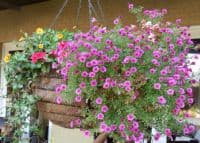
Container Gardens
Growing plants in containers outside is fun and offers many choices and opportunities to be creative. Containers can be portable and used in a number of ways for plantings. Use container plantings as your mini garden, to add color, interest, height, and as a focal point to your home or yard.

The container you select is just as important as the plantings used. Almost anything can be used as a container but drainage holes are important. So drill holes about ¼ in to ½ in containers that don’t have drainage. I like to use coco liner hanging baskets, terra cotta and plastic containers but gardeners are using old shoes, watering cans and unexpected items for creative container gardens.
When designing a container you always want to put plants together in a container that have similar growing requirements such as plants that take full sun with other plants that have similar needs or plants that like dry conditions with others that have the same needs. Choose containers that are large enough to hold the plants at their mature size. Group plants in colors and containers that complement one another as well as the location. Many of us remember the recipe for a good container arrangement is to use a “thriller”, “filler” and a “spiller”. This simply means to use a plant that is tall or spiky in the middle or back of an arrangement as the thriller. Filler means a showy, bushy plant that fills in the middle or sides of a arrangement and a spiller is a plant that cascades or spills over the container edges.

Some good plants to use in containers include coleus, perilla, pansys potato vine, begonia, creeping jenny, petunias, succulents, grasses, miniature roses, geranium, croton, herbs and vegetables to name a few.
While annuals do best, any plant can be used in a container but remember that a container garden is best used for a season or two as plants die and can outgrow a container.

Some mistakes to avoid in container gardening are using the wrong potting mix, fertilizer misuse or incorrect watering. Use reputable brand names when selecting potting soil. Don’t use top soil or soil from your yard because it is heavy. The soil will stay wet and rot the plants. Potting soil containing fertilizer and moisture control is ideal. Once the plants start to grow use liquid fertilizer about every 2 weeks or add slow released fertilizer after about 3 month when the fertilizer in the soil is almost depleted. The more you water, the faster the slow release is used.
Container plants require water more frequently as the season gets hotter. Smaller containers generally require more frequent watering than larger ones. Water plants with a gentle stream. Plants should be watered until water runs freely through the bottom holes to ensure thorough watering. The best way to make sure you don’t water a container too much or too little is to put your finger in the soil about an inch or so to test if it is dry or still wet.
Plants can be trimmed, added or replaced in a container as needed. Treat insects and diseases as they occur with horticultural oils and fungicides during cooler times of the day and according to label directions and enjoy your Container Gardens.

